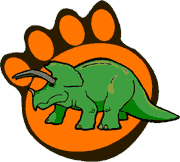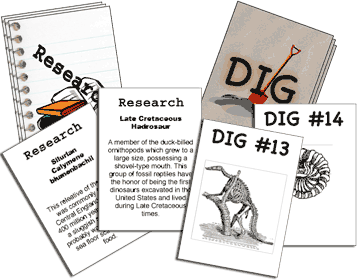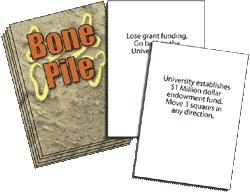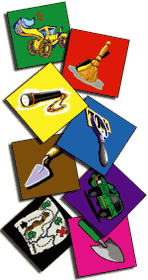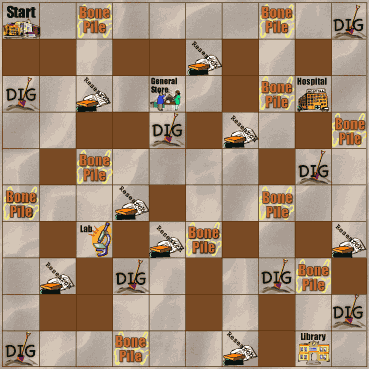|
Paleotopia |
|
| | Instructional Objective | Learners & Context | Object of Game | Game Materials | | Time Required | Setup | Rules | Design Process | References |
It
will reinforce the principle that fossils have recorded a
record of life on earth and help them relate and match fossils
of specific life forms to information known about those life
forms. Variations and the use of a time line can also help
students understand which life forms lived during specific
prehistoric periods.
This game is designed for late middle school (grades 5-6) and early junior high school (grade 7) students studying earth science, life science and evolution. At this point they study the principles of rock stratification, that the fossil record tells a story of the evolution of life on earth and that the composition of rocks and their fossils can be used to match rock strata from different locations. In addition they study how many groups of living things have changed over time, evolved and some have become extinct. Children of all ages are intrigued with ancient life forms and this game will help them make connections between the descriptions of these life forms and their actual images. This game can be used in the classroom as an activity to help them connect their earth science and life science studies. It requires very little set up but teachers can set the stage by talking about paleontology and how paleontologists use what they find in the earth and relate that to what they know from their research. To help students develop critical thinking skills, after playing the game teachers can also discuss with students the kind of connections they made and what they were thinking when they matched specific images with the information they had on hand (in the Research cards.) You're a paleontologist, searching the world for pre-historic remnants and evidence of past life. As you move through the landscape you'll need to dig for discoveries (in the dig spaces) and research for information on what you dig up in your adventures (research spaces.) Your goal is to set out from the University in search of evidence of past life and return after you match 5 Dig Cards with their correct Research Card. Be the first to make it back to the University with your matches and you become the Paleontology Professor and game winner. Click on any Game Material item or picture to obtain a PDF file of that item. To obtain a complete, printable set of rules and game materials in one file (2MB), click here.
You can play the game on a timed basis of 45-60 minutes or until the first player returns with 5 matched cards. If the game is timed, at the end of the time limit the player with the most matched cards wins. Print out game pieces, game board, Bone Pile Cards, and TWO copies of the Research Cards and Dig Cards from the Paleotopia PDF file. You will need a copy of Adobe Acrobat Reader (available free at www.adobe.com), version 5 or later to properly print the files. The Game Board is larger than standard letter sized paper so you will need to select the "Tile Oversized Pages" option in the Adobe Acrobat print menu and then assemble the sections of the board. Lay the board out and divide the Dig cards in 5 equal stacks, face up so you can see the plants and animals on each card. Place the Research cards, face down, in a single stack and do the same for the Bone Pile cards.
We started the process by trying to create a game to go with a Paleontology video we were developing for another project. We wanted to create a game that would help players associate plants and animals with the type of landscapes and geological formations found in ancient time periods. We also wanted to create a game that would give players a sense of some of the issues involved in a paleo dig. We reviewed Cardboard Cognition, searched the Internet and went to a few teacher stores and game stores looking for similar games. (This is still in process.) We were also referred to archeology game and activity sites. We found one game (Dig) that was a paleontology game focused on teaching dinosaur facts. We wanted to make this game encompass more than dinosaurs and wanted to help students make inferences and connections rather than merely teach facts. We worked through the game design process (http://edweb.sdsu.edu/Courses/EDTEC670/boardgame/BoardGameDesign1.html) individually and then compared notes. We reworked the concept several times, and reworked the board design to align the structure of the game with the content we wanted to convey. We showed this idea to friends, family and Professor Bernie Dodge for feedback. Bernie's feedback made us go back to the drawing board to redesign the board and rework the rules. On "Beta Test" night at ET 670 we observed others play and evaluate the game and made several changes. We initially had the Dig cards in one pile but noticed that players made more inferences if they read the research cards and then looked for plants and animals that matched the description. We decided to place the Dig cards face up in 5 stacks so players could choose. The game could also be played the other way, with the Dig cards face down in one stack and the Research Cards face up in 5 stacks and let players match the information to the image, rather than the image to the information.) We also changed several other items. We originally had names and time periods on both the Dig and Research Cards. We took the names off the images so students would have to match information and images rather than just names. We noticed that players tended to stay in the middle of the board and move around the spaces there. We added spaces on the edges of the board that they are directed to by the Bone Pile cards. This will move them out around the board so they don't cluster in the middle. Originally there was only a single set of the Dig and corresponding Research cards but we realized that if an opponent took a card that a player had a match to, that would preclude either from making a match so we created duplicate Dig and Research cards to prevent this. (A variation of the game could be played by allowing players to trade cards and thus make matches quicker.) We learned how hard it is to create a board game that aligns content with the structure of the game. We also learned to be more flexible at the beginning of the game design process so we don't paint ourselves into a corner. In addition our future games will probably not have as much content as this one. We discovered how hard it is to research for content and then place the content on game cards. We developed three different versions of the game further than we probably should have and have documented the two previous versions on another site to illustrate more detail on the thought processes and evolution of the development. Variations Variation A Instead of the setup listed above, place the Research cards in 5 stacks, face up and the Dig cards face down in one stack. When players land on a Research space they can choose any of the face up research cards. This will allow them to match an image with its information rather than vice versa and create a different type of inference and deduction to properly match their cards. Variation B As part of a unit on prehistoric discoveries, earth science or evolution, post a timeline of paleontologic eras on a wall. As students create matches they pin or tape the cards to the appropriate era so they can see the types of life forms that lived during that time. This should further help them make connections to what they are studying about the geologic and paleontologic eras they are studying because they will see the shapes and types of plants of those eras gradually build as they pin their cards on the timeline. Extend the Game To extend the game to specific time periods or units of study the teacher or students can create more cards specific to the unit of study.
Books & Journals
Electronic
|
